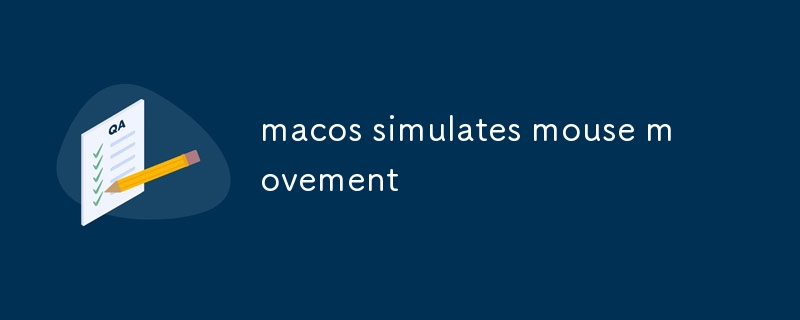macos模拟鼠标动
- DDD原创
- 2024-08-14 15:27:231046浏览
本文讨论了使用代码、AppleScript 和 Automator 在 macOS 上控制光标移动和自动执行鼠标操作的各种方法。它解释了如何使用 CGEventCreateMouseEvent 函数进行精确的光标控制,并提供示例

如何使用代码控制 macOS 上的光标移动?
使用代码控制 macOS 上的光标移动有多种方法。一种方法涉及使用 Core Graphics 框架中的 CGEventCreateMouseEvent 函数。此函数允许您创建具有指定属性的鼠标事件,例如光标位置、按钮状态和时间戳。然后您可以使用CGEventPost函数将事件发送到系统。CGEventCreateMouseEvent function from the Core Graphics framework. This function allows you to create a mouse event with specified attributes, such as the cursor position, button state, and timestamp. You can then use the CGEventPost function to send the event to the system.
Here's an example of how to use CGEventCreateMouseEvent and CGEventPost
CGEventCreateMouseEvent和CGEventPost来移动的示例将光标移动到屏幕上的特定点:<code>#include <CoreGraphics/CoreGraphics.h>
int main() {
// Create a mouse event with the desired cursor position
CGPoint cursorPosition = CGPointMake(100, 100);
CGEventType eventType = kCGEventMouseMoved;
CGMouseButton button = kCGMouseButtonLeft;
CGEventRef event = CGEventCreateMouseEvent(NULL, eventType, cursorPosition, button);
// Post the event to the system
CGEventPost(kCGHIDEventTap, event);
// Release the event
CFRelease(event);
return 0;
}</code>
是否可以在 macOS 应用程序中自动执行鼠标操作?是的,可以使用 AppleScript 或 Automator 等工具在 macOS 应用程序中自动执行鼠标操作。 AppleScript 是一种脚本语言,可让您控制 macOS 的各个方面,包括鼠标的移动和单击。 Automator 是一个图形工具,可让您通过组合预定义的操作(包括鼠标操作)来创建工作流程。以下是如何使用 AppleScript 将光标移动到屏幕上的特定点的示例:<code>tell application "System Events"
set theX to 100
set theY to 100
set mousePos to {theX, theY}
set frontWindow to window 1 of process "Finder"
set mouseLoc to mouse loc of frontWindow
set mouseLoc to mousePos
end tell</code>
我可以创建脚本吗在 macOS 上执行重复的鼠标手势?是的,您可以使用 AppleScript 或 Keyboard Maestro 等工具创建脚本以在 macOS 上执行重复的鼠标手势。 AppleScript 是一种脚本语言,可让您控制 macOS 的各个方面,包括鼠标的移动和单击。 Keyboard Maestro 是一款商业自动化工具,它提供了用于创建和管理宏的高级功能,包括对鼠标手势的支持。以下是如何使用 AppleScript 创建脚本来重复将光标移动到屏幕上特定点的示例: 🎜rree以上是macos模拟鼠标动的详细内容。更多信息请关注PHP中文网其他相关文章!
声明:
本文内容由网友自发贡献,版权归原作者所有,本站不承担相应法律责任。如您发现有涉嫌抄袭侵权的内容,请联系admin@php.cn
上一篇:Claude保姆级注册教程下一篇:echarts 添加标注线

